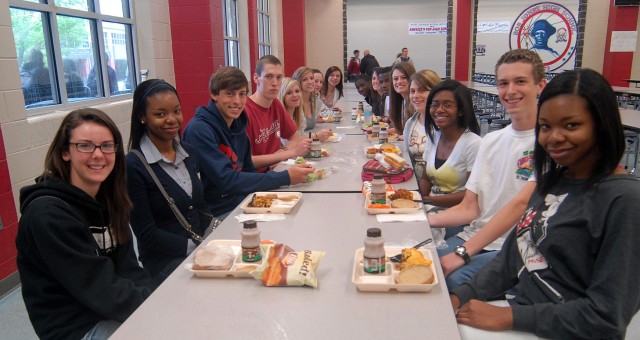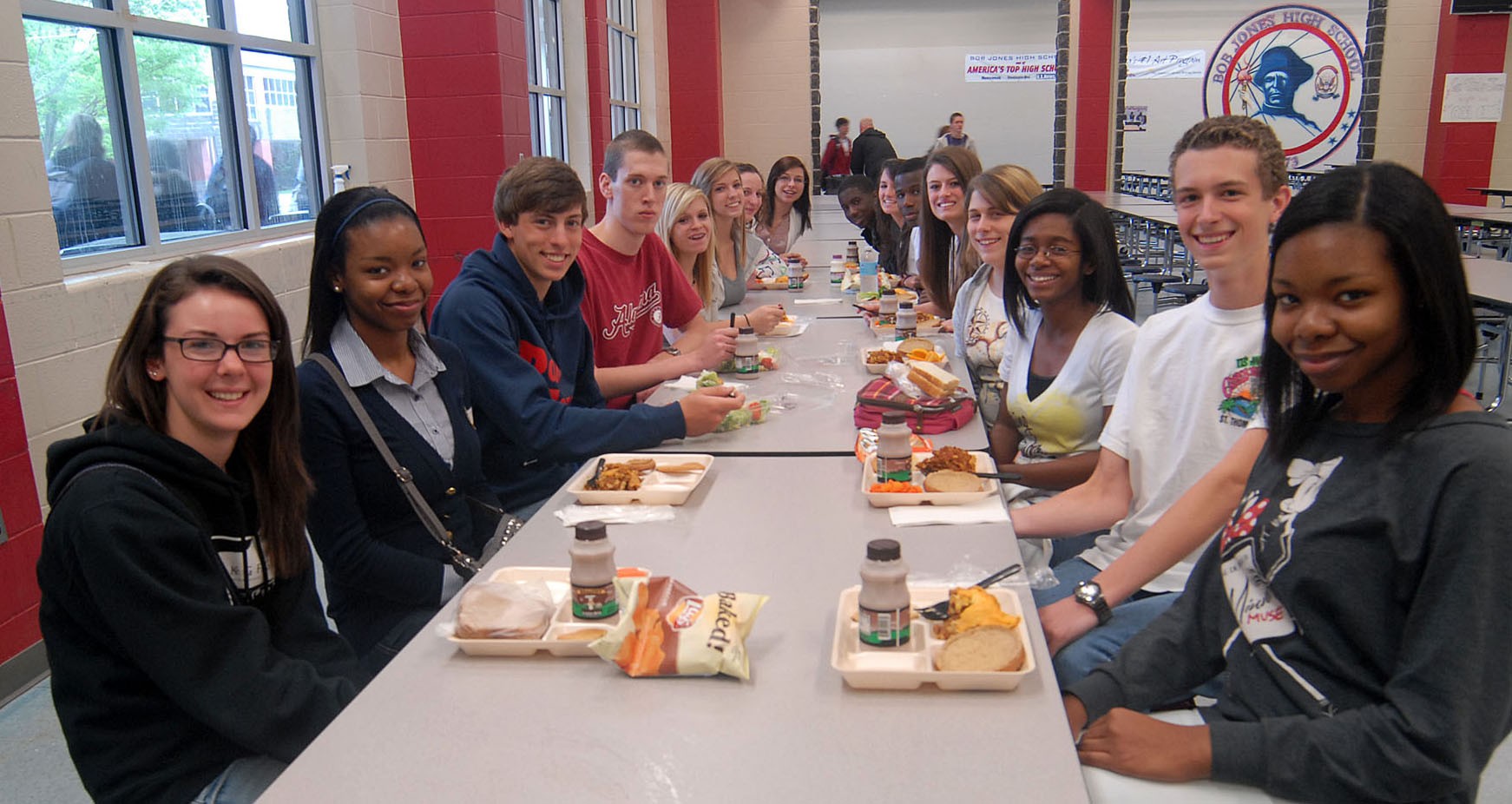REDSTONE ARSENAL, Ala. -- The places Melissa Dryer has lived reads like an atlas.
New York, Alaska, Tennessee, Texas, California, Iowa, North Carolina, Louisiana - the 17-year-old has called them all home as a military child. With each move came a new school for the Bob Jones High junior, new friends, and new challenges.
"It was difficult to have to pick myself up and move every year," Dryer said. "Having to make new friends was the hardest. Trying to settle back down, knowing that you're just going to go somewhere else is kind of difficult. You didn't really want to make that attachment to friends."
They come from across the country and the world, places like California, Iowa, Texas, Thailand, Colombia and Uganda, but the anxieties and fears of new students coming in to a new school are one in the same - who will I eat lunch with' Where are my classes' Will I make new friends' As the largest high school in Alabama, Bob Jones High in Madison boasts a student body population of approximately 2,300, roughly the size of a small town that's only growing with BRAC movement. Since the start of the school year, Bob Jones has added more than 170 new students, over in Huntsville, Columbia High has welcomed approximately 130 this year. As the numbers of incoming students across the Tennessee Valley show no signs of slowing, reaching out to new pupils, many with a military connection, has become a priority for both students and educators.
"Transitioning students need to know that other students have gone through the same move-related issues they are experiencing," Dr. Jennifer Garrett, principal of Columbia High in Huntsville, said. "There are the typical issues of saying goodbye to old friends and trying to make new friends and adjusting to a new class schedule and teachers. Then there are the adjustments regarding different standards for graduation from state to state and county to county. Our goal is to ease those bumps in the road during the transition."
The Student 2 Student program, available at both Bob Jones and Columbia, takes away those bumps by providing peer helpers, or ambassadors, to guide newcomers through the transition. Ambassadors eat lunch with new students, field questions, help them navigate the school, and introduce them to athletics and other extracurricular activities.
"The S2S program brings the transitioning student into the Columbia family and makes them feel a part of the Columbia tradition," Garrett said. "Indeed, the transitioning student program is a part of the Columbia tradition. The new students adapt more easily and are welcomed in the athletic programs, the arts, the academic programs, wherever their niche is, we help them find their place at Columbia. Within weeks, the new students are no longer new, but are part of Columbia."
As the new students continue to assimilate into their educational environment, the peer helpers continue to provide outreach to the students - at least two new student luncheons are held each year at Bob Jones, which gives the newcomers time to get acquainted with each other, and Columbia's ambassadors host S2S Recess, where the new students and their guides get together to play games, share information and discuss interests and hobbies. The S2S program, according to Barbara Williams, youth education support services director for Child Youth and School Services, makes all the difference between a successful and unsuccessful transition for the new student.
"It means everything," Wiliams said. "It's a lifeline. Many of the students are resilient, but some are not. Some have real fear and concerns about moving. You get integrated a lot quicker into the school and school activities, as opposed to going day by day to see if I can step up a bit more. Somebody's already reaching out to you."
Summer Dawkins is all too familiar with being the new kid. Growing up with her father in the Air Force, she's gone through the emotions of coming to a new school, many times. Today as a peer helper at Bob Jones, she uses her experiences to bring newcomers out of their sense of isolation.
"I know what it is like to be the new kid," Dawkins said. "Being part of this, I can make it a little easier. It feels like we're making a difference. We're reaching out."
Now that her father is retired, Dryer has broken the cycle of being the new kid, and instead serves as a peer helper.
"Knowing I can help out so many new students that have been through this tons of other times, just like me, I can really relate," Dryer said.
For educators Bridget Drummond and Michael Hoyle, who together lead the program at Bob Jones, the impact can be seen in the way the new students carry themselves within just a few days, weeks, and months at the school.
"I think these kids really help the transition," Hoyle said. "You're coming in to the biggest high school in the state of Alabama. It's overwhelming. If you don't know anybody or have anybody here to guide you at least through the first day, you can get lost in the shuffle. I think these guys have made a tremendous impact on new kids, because we do, we do see new kids and they're walking around with friends they've made and people they've been introduced to."
Sparkman High School and Discovery Middle School are both in the process of developing Student 2 Student Programs, according to Jennifer Craig, guidance counselor at Sparkman, and Sharon Willis, principal of Discovery.
At Grissom High in Huntsville, it's all about establishing connections through the school's REACH program, which, like Student 2 Student, pairs new students with volunteers from the student body to help newcomers establish themselves within their new school.
Student helpers go beyond the basics of just teaching the new kids on the block how to navigate Grissom, and actually get to know the new student to the point where they can recommend activities and organizations that fit their interests, and introduce them to others that share those same interests. How long an individual remains in the REACH program varies, depending upon how quickly they assimilate to their new environment or how much assistance they desire.
"We want our students to feel welcome," said Laura Worshim, assistant principal. "We want them to know it's going to be okay."
Being a new student is all fun and games - literally - at Lynn Fanning Elementary School in Meridianville where new students participate in a scavenger hunt to get to know the school better. Accompanied by a Student Council member, new students are provided with a checklist to complete, such as getting a thumbs up and coupon for free ice cream from the lunch ladies, visiting the playground to discover their favorite area and stopping by Mrs. Plant's office, the school principal, for a special surprise. Scavenger hunts typically take place within a week of the student's first day of school, according to Melissa Pogue, school counselor, who came up with the idea after a Military Child Education Coalition institute in 2007.
"It's just a great way for the new students to meet other children and to learn about our school and meet faculty from a peer instead of an adult," Pogue said.
Once a military child has adapted to their new educational environment, the support does not stop. The pictures on the Veterans Wall at Harvest Elementary School in Harvest tell the tale of the military children that call the school home. Each Veterans Day, students with parents in the military bring in photos of their loved one that remain on display throughout the school year. Approximately 30 pictures decorate the board today.
"The wall is something that's very special to them," said Rachel Rosenberg, school counselor.
Military connected children are given special care through the Military Child Support Group. Students meet once a week for a half hour, six weeks prior to breaking for Christmas, as well as six weeks before summer break, to help them prepare for what may be an emotionally trying time at home.
"That's one of the hardest times for them if mom or dad is deployed through the holiday season," Rosenberg said.
Creative play mixes in to the sessions to help the students learn about and cope with the emotions they may be going through with activities such as "Pipe Cleaner Characteristics" where students work with pipe cleaners, and "What Bugs Me," an activity where students create their own little bugs to help them discuss what's bothering them.
"The pipe cleaners are flexible, just like the military family has to be flexible," Rosenberg said. "That's to help them understand that they have to be flexible, because their lives change depending upon whether or not mom or dad is deployed. We have to be ready and flexible for when that happens."
The group discusses their feelings, what makes them happy, like using Skype to talk to their parent who is deployed, as well as what makes them sad or angry, like not having their parent there for summer vacation.
"The whole point is to understand there's no right or wrong feelings," Rosenberg said. "It helps for them to know they're not alone in their feelings."
Since the group has been instituted, teachers have noticed a difference in their students, as they have developed coping skills to help them come to terms with issues at home that often left their little minds wandering during class time.
"It was always on their mind," Rosenberg said. "They weren't being as attentive in the classroom and not doing as well as they could. This gives them an area where they can get it all out. It helps them focus their attention on their schoolwork and classroom."


Social Sharing